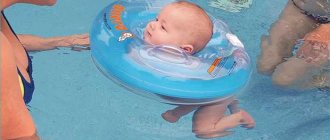How does an orthopedic collar work?
Many people who have had to deal with unpleasant sensations in the neck area are interested in how an orthopedic collar works. This device is also known as a Shants collar (or splint). Its main purpose is to gently fix and stabilize the cervical spine. It helps to provide soft support to the head, as well as partially relieve the musculo-ligamentous apparatus of the cervical spine.
In other words, the Shants collar makes it possible to fix the cervical spine in the required position, and also limits excessive mobility of the cervical vertebrae. The result is a gentle correction of the neck position, slight traction and a weak massage effect.
Indications for use
The Shants collar for children is the simplest type of orthosis made of soft elastic material with Velcro at the ends. With its help, you can adjust the size of the device and increase the wearing comfort. In medical circles, this device for newborns is called a therapeutic splint; popularly it is simply called a “collar.”
Indications for wearing a Shants collar by newborns:
- cranial and spinal injuries during childbirth;
- application of obstetric forceps;
- muscular torticollis or short neck syndrome;
- vacuum extraction of the fetus;
- delivery by cesarean section;
- motor activity disorder.
The Shants gate is used in the complex therapy of premature and weakened children who are unable to hold their head up, to correct neurological symptoms due to craniocervical trauma. The combination of polyurethane foam with an anatomical shape promotes uniform distribution of pressure on the points of support without injuring or compressing them.
Prescribing the Shants splint to newborns is possible as a rehabilitation aid after surgery on the upper cervical spine or to preserve the results of manual treatment.
There are no special restrictions on the use of the Shants collar for infants. It is not recommended to wear a bandage only in case of damage to the skin on the neck (wounds, scratching, various allergies and eczema). The use of an orthosis in this case will lead to an exacerbation of the pathological condition.
If the baby does not feel very well in the bandage, shows anxiety, cries and is capricious, it is better to remove the device and contact a pediatric neurologist. Perhaps the size is incorrect or the child really cannot wear the collar. The doctor will decide what to do in this case.
Only an orthopedist can decide whether a child should wear a brace and for how long. The danger of the fixator is that it takes on part of the load of the muscular system.
If you follow all the doctor’s recommendations, the child will develop without delay.
There are a number of indications for which doctors prescribe wearing this orthopedic product:
- congenital and acquired torticollis;
- short neck syndrome;
- increased excitability of the baby;
- depression of the nervous system;
- damage to the cervical vertebrae during birth.
Torticollis in infants requires treatment
Indications and contraindications for use
The main indication for the use of a splint collar is a variety of diseases of the cervical spine. In addition, this device can help in the prevention of a wide range of diseases of the cervical-collar area, which primarily affect office workers who spend a lot of time at the computer. The collar makes it possible to remove the load from the muscular frame of the neck and at the same time supports the head. In addition, it has a very gentle cervical massage effect and at the same time helps to ensure immobilization of the neck during the recovery process after injury.
All of the above determines the main indications for the use of an orthopedic collar. Thus, it has proven itself well in cases of osteochondrosis and moderate injuries of the cervical spine. Its use is recommended for myositis - in other words, muscle inflammation of various etiologies. Pediatricians recommend wearing a Shants collar to newborns if they have been diagnosed with symptoms of muscular torticollis. This device also helps to recover from injuries and surgical interventions, helps with postural disorders, spinal cord compression and neurological pain.
At the same time, despite the undoubted effectiveness of the orthopedic collar, there are a number of diseases for which its use is categorically not recommended. Thus, you should avoid using the Shants collar if you have any dermatological diseases in the shoulder and neck area. In addition, it is not suitable for patients with too severe a spinal injury or with significant spinal instability in the cervical region. In this case, other, much more difficult to use, means will be needed.
Wearing rules
To avoid inflammation and irritation, the child’s skin under the retainer should always be dry and clean. The orthopedic product should be washed as needed in cool water by hand, drying should take place naturally in a straightened form, otherwise deformation is possible.
Not only its effectiveness, but also its safety for the child’s health depends on how the Shants collar is put on, so a doctor should show you how to put it on the first time and give instructions. To be sure, you can also watch a video demonstrating the process, or use the description below:
- attach the collar to the child’s neck: the convex part will be under the chin;
- the cutout at the top of the collar should also be located under the chin;
- the clasp, accordingly, is at the back;
- When fastening the collar, leave 1-1.5 cm of free space between the neck and the splint.
DETAILS: Diclofenac ointment characteristics features of use dosage price
The doctor determines how long the child will have to be kept in the orthopedic collar. We can only say that some are prescribed 10 minutes a day, other children wear it around the clock. The period is also determined by the doctor. We advise you to wear the bandage after physical therapy or a massage session - this will increase its effectiveness.
Keep the collar and skin of the child clean, because skin irritation becomes a reason for removing the bandage, and this affects the treatment and increases its time. It resumes only after the skin has completely healed. In most cases, doctors prescribe wearing a Shants collar for one month from the moment of birth.
The wearing pattern is determined by the attending physician. It takes into account the stage of the pathology, the degree of damage to cartilage and bone tissue, and the likelihood of complications. The orthopedic device is used from the first days of therapy. Wearing it is always combined with physiotherapeutic and massage procedures. During daily exercise therapy and gymnastics, the collar must be removed.
Typically, wearing time does not exceed 4 hours a day. The collar must be removed before going to bed or during the daytime rest, since in a lying position it strongly compresses soft tissues and blood vessels. Constant use of the device causes a decrease in the tone of the skeletal muscles of the neck, and in severe cases, muscle atrophy.
But in some situations, the doctor may recommend not to remove it even at night, for example, during the rehabilitation period after fractures. To improve the quality of sleep and prevent compression of the vertebral artery, it is necessary to use an orthopedic pillow with a recess for the shoulder.
Types and properties of the Shants collar
Orthopedic collars have several varieties, which differ mainly in the material of manufacture. There are no functional differences between them. However, in order to choose the right Shants collar, you should definitely consult a doctor.
Soft tire
In order to provide easy traction of the cervical vertebrae and suppress the unpleasant symptoms that arise during sedentary work, orthopedists recommend using a therapeutic soft collar (splint). It is usually made from special medical foam rubber or other material characterized by increased elasticity and porosity.
Externally, such a collar is a flexible strip that has a special anatomical notch designed for the chin, as well as Velcro, with which you can reliably fix the position of the neck.
This orthopedic device limits head tilt and also prevents the development of cervical osteochondrosis. The mechanism of action of such a collar is that dosed pressure helps relieve the load on the cervical spine and also promotes damping traction.
Wearing such a splint is usually recommended for children, in particular in the case of torticollis in newborns. In addition, it has proven itself well as an adjuvant for myositis, osteochondrosis, as well as for rehabilitation after cervical injuries.
Inflatable collar
An inflatable collar is a frame that is made of a material that is high density, but at the same time flexible. An inflatable mechanism is located between the strips of the base material. Such devices are inflated using a special bulb.
The purpose of such a collar is to gently stretch the spinal column and stimulate blood flow. At the same time, it allows you to fix the spine in the required state and slightly limits the mobility of the neck.
Semi-rigid and rigid collars
The main purpose of an orthopedic collar with semi-rigid and rigid fixation is to support the head, thereby relieving the load on the muscles and vertebrae of the cervical spine.
A semi-rigid collar is usually made of polyurethane. The entire structure is covered in fabric and has a clasp at the back. The collar helps to support the head in a certain position, and in addition, has a warming effect, due to which it has a positive effect on problems of the muscular-articular system. This device is used for diseases of the cervical spine, when it is extremely important to limit the mobility of the neck. For example, it is used for minor fractures or cracks of the cervical spine, for dislocations, as well as during the rehabilitation period after surgical operations. It can be used either with a cotton fabric lining or simply on a naked body. It has several sizes, varying in neck circumference (from 30 to 46 centimeters), and height varies from eight to twelve centimeters.
The main difference between a rigid collar and a semi-rigid one is that when using it, the motor activity of the cervical spine is almost completely limited, since it is made of a rigid thermoplastic material. It is modeled individually, directly on the patient’s body, and then fixed from behind. It is recommended for use during postoperative recovery during operations on the neck muscles, as well as for any spinal injuries in the cervical region.
The rigid collar design always includes submandibular and posterior supports, which help provide significant immobilization. Rigid collars are used for fracture-dislocations, torticollis, as well as for severe instability of the vertebrae of the cervical spine, to eliminate the consequences of fractures of the cervical spine. A rigid collar is made of metal or hard plastic, which reliably fixes the spinal column in one position. At the same time, there are often cases when prolonged wearing of a hard collar led to ischemic problems, as well as pain in the chin and lower jaw.
Orthopedic collar for children
Separately, it is worth mentioning orthopedic collars intended for children. Doctors recommend wearing a Shants collar for children who need to temporarily limit the mobility of the cervical spine. The most common cause of this is a variety of neck injuries.
A children's orthopedic collar is a strip, which is usually made of highly elastic polyurethane. Such a device clasps and gently fixes the baby’s head and neck in exactly the position that is currently physiologically beneficial. At the same time, there is also stretching of the muscles cramped by spasm, restriction of excessive mobility of the cervical spine, blood circulation is stimulated and pressure on the nerve endings is reduced.
The Shants collar helps return displaced cervical vertebrae to the correct position, eliminates associated pathologies, and helps avoid accidental injuries to the cervical spine. It is also recommended to wear it during the rehabilitation period after surgery.
It should be noted that although an orthopedic collar helps return displaced cervical vertebrae to the correct position, its wearing should be combined with other treatment methods. This could be massage, gymnastics, or the use of an orthopedic pillow.
Children's orthopedic collars vary in size, which depends on the circumference and height of the child's neck. The latter is measured from the middle of the collarbone to the angle of the lower jaw.
An orthopedic collar is put on the child in such a way that the baby’s chin is located in the notch located in the middle of the upper edge of the device. The design is fastened on the back of the neck with Velcro. Be sure to ensure that the collar fits tightly against the skin over the entire surface of the neck. In this case, the child’s chin and cheeks should not “fall” inside the structure.
At the same time, you should also not fasten the collar too tightly. This can lead to breathing and circulation problems in the cervical spine.
Orthopedic collar for newborns
There is also another special category of orthopedic collars - Shants collars for newborns. These devices are known among young mothers as “collars.”
The Shants collar for newborns is a collar made of foam rubber with a height of 3.5 to 4.5 centimeters. At its ends there are Velcro strips that help regulate the volume of the tire.
Orthopedic collars for newborns are intended for use by children up to six months. Indications for wearing it are not only torticollis and problems with the cervical spine, but also hyperexcitability, some movement disorders, short neck syndrome, etc. Naturally, the final conclusion about the need to use this device in each specific case is made by the doctor.
As a rule, the use of a Shants collar is prescribed to a baby immediately after birth. The duration of its use is a month, but other options are possible. The peculiarity of the Shants collar for newborns is that it should be worn constantly, taking off only when bathing the baby. Less commonly, doctors recommend wearing this design in so-called “sessions” for 10-15 minutes a day.
Many young mothers share the misconception that due to the use of this device, the child will later learn to hold his head up. However, in reality this is not the case. An orthopedic splint for newborns does not interfere with the baby - it just limits movements that could cause him pain. In addition, this device has a slight warming effect and relaxes the muscles, as a result of which the baby becomes calmer and hyperexcitability goes away.
Please note that the orthopedic collar for newborns is put on the baby in such a way that there is a free space of approximately a finger's width between the neck and the structure. Its presence is usually checked on the posterolateral surface of the neck.
The main thing that parents need to remember, whose baby the doctor recommended wearing a Shants collar for newborns, is the fact that the baby’s skin under the splint should always be clean and dry. Otherwise, irritation, redness and soreness may occur.
With prolonged use, the children's orthopedic collar becomes dirty. Therefore, it would be advisable to purchase two or more products at once so that you can wash them alternately. Washing should be done very carefully, without using synthetic detergents. It is best to wash orthopedic collars for newborns by hand using baby or laundry soap. The tire should be dried flat, away from heat sources. After the bandage has dried, carefully inspect it - there should be no folds on it that could irritate the baby's delicate skin.
Key points to keep in mind
Before purchasing a collar for a newborn, you must remember that only the attending physician can prescribe it. It is needed in cases where the child suffers:
- depression of the central nervous system;
- hyperexcitability;
- motor dysfunctions;
- from curvature of the cervical vertebrae;
- short neck syndrome.
Since each baby is individual, when choosing such a collar, parameters such as body weight and volume must be taken into account. A good option would be to visit an orthopedic store. Here you can find medical splints of all sizes and colors.
Rules for selecting a Shants collar for a child
The choice of “collar” should be given maximum attention. If you choose a short one, it will constantly go astray and cause a lot of inconvenience to the little patient. In the case of a long collar, there will be no benefit for infants, because it will not be able to perform its direct duties (restoring the functionality of the cervical vertebrae). An important clarification is the fact that the required size for a child (more precisely, the height of the tire) on average ranges from 3 to 5 cm.
It is best to make a custom-made neck splint, since a standard one may not be suitable for a newborn. After the measurements are taken and the “collar” is made, it is necessary for the specialist to demonstrate how to properly put it on and how to wear it. The doctor will also tell you how much time a day the child should wear the collar without removing it from the neck.
To ensure that the baby does not have a negative emotional state, before putting on the splint, it would be useful to do a short massage or a short warm-up. This will greatly increase the effectiveness of wearing and will not be perceived so critically by newborns.
An important condition is maintaining hygiene, because a baby’s skin is delicate. If cleanliness and order are not maintained, the child will develop redness and quite severe irritation of the surface of the epidermis. All this is necessary in order to create more comfortable conditions for the newborn. If you do not adhere to this rule, long-term wearing of the orthopedic structure will not be possible.
If the parents of a small patient do not understand (or are completely sure) how to wear a child’s collar, they should immediately seek help from a doctor. An incorrectly applied medical splint will not bring the expected result; it will become one of the main factors of harm for the newborn (the neck muscles will be weakened, and because of this, even at two months of age the baby will not be able to hold his head up on his own). That is why maximum attention should be paid to this condition. If you miss even one rule and take the wrong step, the results can be very disastrous.
How to choose a Shants collar
To ensure that wearing a Shants collar does not cause severe discomfort, several important nuances should be taken into account when choosing.
First of all, remember that once the splint is in place, neck mobility will be limited. It will be impossible to tilt your head back or tilt it forward. Therefore, the collar is put on exclusively in a position where the neck is straight and the head is level.
The height of the collar is important. The lower part of the Shants collar in front should rest against the bones of the collarbone, and in the back it should be located right at the base of the neck. The upper edge of the accessory should support the jaw in front and reach the base of the skull at the back.
A properly selected collar should not rub the neck, interfere with swallowing and lower jaw movements, squeeze the neck, or prevent head turning. One finger should fit freely between the skin and the inner surface of the bandage.
If the collar is not chosen correctly, patients may complain of a number of unpleasant symptoms. This may include weakness, attacks of dizziness, fainting, nausea and vomiting, severe pain in the neck muscles and lower jaw. If any of these symptoms occur, the cervical collar should be removed and medical advice sought. The specialist will suggest using a different modification of the design or adjust the degree of its compression.
What to do if your baby is bothered by an orthopedic collar
Many mothers whose babies are prescribed a neck brace complain that their babies start crying when they put the product on. The crying period is long, and it is almost impossible to calm the child. Contact your doctor again. Perhaps the size is chosen incorrectly, or the mother is putting it on incorrectly and fastening the collar too tightly.
If everything is done correctly, but the crying does not stop, then put on the collar after or before pleasant manipulations. You can bathe your baby and put on the splint immediately after bathing, but before feeding. You can put on a bandage at the end of massage and physiotherapy, if the baby is in a good mood after them.
Now on many forums, young mothers share their experiences and discuss the question: to wear or not to wear an orthopedic collar. There is an opinion that you can ignore the recommendations of a specialist and not wear a fixing collar, that the child will not begin to hold his head up in time, that it is painful and uncomfortable for him to wear it.
To raise a healthy baby, do not neglect your doctor's recommendations. If you have any doubts about using an orthopedic collar, consult several specialists.
Reviews about the effectiveness of the Shants collar
The effectiveness of using the Shants collar is confirmed by numerous positive reviews from patients. People note that when using this accessory, painful sensations quickly disappear, and wearing it is quite comfortable. Office workers are especially pleased with the use of the Shants collar - in particular, those who have to sit at a computer for a long time. Also, some note the positive effect of the collar during hypothermia.
There are, however, those who complain about the lack of any effect or discomfort caused by using the Shants splint. In particular, some claim that their headaches have worsened. The cause of this reaction is usually the wrong choice of collar or using it for too long a time.
How long to wear a Shants collar
Patients for whom a doctor has prescribed the use of a Shants collar are interested in the question of how long this device should be worn. Alas, there are no universal recommendations on this matter. The duration of use of the device in each specific case should be determined by a doctor.
Most often, for minor injuries and pain, adults are advised to use an orthopedic collar for approximately a quarter of an hour daily. For people suffering from osteochondrosis, doctors usually advise using the collar twice a day for an hour, for example, while reading or watching TV.
It should be borne in mind that although you can sit and walk in the collar, you should never lie in it, because in this position strong pressure on the fixed cervical spine can lead to deformation of the vertebrae. In addition, it is strictly forbidden to wear an orthopedic collar all the time, as this can lead to complete atrophy of the neck muscles.
Doctors recommend combining the use of the Shants collar with physical therapy, massage, and the use of an orthopedic neck pillow.
Orthopedic splint care
When a neonatologist prescribes wearing a splint for a newborn, a young mother often has doubts: she is afraid that the child will be scared or uncomfortable, that the collar will harm him. Probably, excessive anxiety is explained by the condition of a woman who has just given birth. In fact, the Shants collar has a number of positive effects on the newborn’s body. As a result of wearing a splint, the following occurs:
- The vertebrae of the cervical area acquire a normal position.
- Blood circulation to the brain improves.
- Proper development of the baby is ensured.
- The neuromuscular system is normalized. The affected muscles relax and recover.
- The warming effect reduces pain.
- The tire has micromassage properties.
- Healthy sleep is ensured, so the child can sleep without removing the collar.
How long should the product be worn? In case of congenital injuries, the Shants collar is put on immediately; the wearing period is usually 1 month. Your doctor will recommend the optimal amount of time to wear the collar each day, which can range from a few minutes to 24 hours. His decision depends on the severity of the injury, age and other individual characteristics of the small patient.
After a month, it is recommended to visit an orthopedist, neurologist and pediatrician, who will decide whether to continue using the collar.
The main criterion for distinguishing collars is the degree of fixation of the cervical region, in other words, its hardness or softness. Shants collars with the same rigidity are produced by various companies, domestic and foreign, which affects not so much the quality as the cost of the product.
Soft fixation
Usually, soft fixation collars are used for minor cervical correction or even its prevention in premature babies immediately after birth. Models OV 001, OV 002 are made from modern synthetic materials that will not cause allergies. They warm and calm the baby. Price from 250 rubles.
DETAILS: Vertebrogenic lumbodynia, what is it?
Medium fixation
In some cases, it is necessary to hold the baby's neck with a more rigid clamp. produces Shants collars of moderate fixation. They are filled with polyurethane foam and covered with cotton fabric. The volume can be changed using a Velcro fastener. The height of the product for night sleep is 3.5 cm, the price is from 105 rubles. There are models TV-001 and TV-002, which differ in height (5 and 8 cm) and are intended for constant wear.
In addition, you can find the F-300 bandage on sale with a foam rubber filling consisting of polyamide, latex, cotton and polyester. The covering is made of cotton fabric, the fastener is Velcro contact tape. This bandage costs from 128 rubles, its height is 4 cm.
The most expensive moderate fixation collar is imported from Germany. This is an Orlett BN-6-53 tire, for the manufacture of which a special bioinert cold-formed polyurethane was used. The outside is lined with viscose and polyester knitwear. Cost from 350 rubles.
You need to pay attention, perhaps, to only three principles that will help to secure the collar on the child’s neck correctly:
- The Velcro fastener should secure the collar at the center of the back of the neck.
- For the newborn's chin, there is a recess in the splint (so the lower part of the splint will rest on the collarbones, the upper part will support the chin).
- Excessive tightening of the collar is unacceptable; this can cause the baby to suffocate. It is also unacceptable to loosen the splint, since its therapeutic effect will be lost.
To understand whether the splint is optimally fixed, the mother’s finger should be placed between it and the child’s neck.
The attending physician should tell you how long to wear the Shants splint. The determining factor in this case will be the reason why the splint was prescribed to the newborn. Wearing the collar may take only a few minutes a day, or may not be removed for an entire month.
The collar may not be worn during:
- Taking a bath for a newborn.
- Massage.
The Shants collar used for newborns is very important to keep clean, since the baby's skin is especially sensitive. Washing the product in cool water will be considered care for it. There is no need to dry the collar; let it dry naturally.
In general, the Shants collar is an effective way to combat neck injuries in newborns during childbirth. The most important thing is to follow the rules of its operation. It must be remembered that only an orthopedic doctor decides whether a child should wear a splint or not.
A product that can provide healing properties can only be purchased at specialized services. It is important to know that home-made Shants splints are strictly prohibited for use, as they can lead to serious consequences and, as a result, disability of the newborn.
Cervical osteochondrosis is a disease that is not yet completely curable, the course of which alternates between relapses and remissions. If it worsens, the Shants collar should be worn until the pain in the neck completely disappears (about 5-10 days). Vertebrologists recommend wearing it even when stable remission is achieved to prevent relapses for 3-4 hours daily.
The maximum benefit can be obtained if the Shants collar for children is properly cared for. It must be kept clean at all times. This design can be washed by hand and only in cold water. It should be dried flat. Do not wash in washing machines, dry in automatic dryers or use other heating devices.
Orthopedic neck pillow
An orthopedic neck pillow is another way to prevent pain and the development of diseases of the cervical spine. The main target audience of these accessories are office workers, travelers, drivers - in short, those who, due to their occupation, are forced to sit for a long time. This device will also benefit all patients suffering from osteochondrosis.
Types of cervical orthopedic pillows
Today, there are several types of cervical orthopedic pillows. They differ in their purpose, form factor, and the filler used by the manufacturer.
The most popular are the collar pillow and the bolster pillow. Let's take a closer look at them.
The collar pillow is also often called the “travel pillow.” It is shaped like a horseshoe and is designed specifically for those who spend a lot of time on trains, planes and buses. During a trip, even if the chair is quite comfortable, the neck muscles do not get the opportunity to rest due to being in a sitting position. It is this problem that the orthopedic “horseshoe” is designed to solve, which tightly clasps the neck from the back and sides, fixing the person’s head in the most natural position. As a result, the load on muscle tissue is reduced, and a person has the opportunity to relax and even fall asleep in a sitting position. It is noteworthy that after sleeping with such a pillow, there is no unpleasant sensation in the neck, so familiar to those who have had to repeatedly doze off in transport.
An orthopedic cushion cushion is a cushion of variable thickness. It can also be used for sedentary work. In particular, this accessory is extremely popular among drivers, as it provides support for the head and neck, without limiting their mobility or blocking their view. In addition, it can be used by people who spend a lot of time on the computer.
There is also an orthopedic pillow called a double bolster. It consists of two rollers of different heights and is intended for sleeping. Thanks to its unique form factor, you can sleep on this pillow in different positions: on your back, using a high bolster; on the side, using either a high or low bolster, depending on how firm the mattress is; on the stomach using a low roller.
Orthopedists say that such pillows provide excellent support for the head and neck, helping to relax muscles and normalize sleep. It is noteworthy that such a pillow is placed only under the head and neck, while the person’s shoulders lie directly on the mattress, due to which there is no deformation of the spine.
An important role, however, is played not only by the form factor of the orthopedic pillow, but also by what kind of filler the manufacturer used.
Orthopedic splint care
A correctly selected collar will create a minimum of discomfort for the baby
The Shants collar is purchased taking into account the age, weight and size of the baby. Although the collar is labeled “for newborns,” it is used up to 6 months of age, and in some cases up to a year. It is obvious that the above indicators are different in children. The main thing is that the collar should be the right size for the baby.
The required collar size is determined based on the distance between the chin and collarbone. You should entrust this to your doctor; do not try to select the size of the device yourself. A splint that is too short will slide on your neck, and a splint that is too long will put pressure on your chin. Neither in the first nor in the second case the functions of the collar will be implemented.
It is advisable that a doctor put the splint on for the first time. He will also instruct parents on how to properly apply the splint. There should be a collar dimple under the baby's chin. The splint is fastened at the back with Velcro: it is important that the fit is not tight - 1–1.5 cm. To make sure that the collar is fastened correctly, place your finger between the splint and your neck: it should fit freely into this gap. The splint should completely cover the neck, with the cheeks and chin positioned above it.
The neck length of all babies is different. And if the collar is not adjusted to size, instead of benefiting it, it can cause harm and lead to complications.
In addition, the child should be comfortable, because the product will have to be worn for more than one day. Therefore, if friends offer to save money and use the tire that their child wore, it is better to refuse.
You cannot select sizes yourself. This should be done by a doctor. To do this, he measures the distance from the angle of the lower jaw to the middle of the collarbone, and based on these measurements, parents order an individual retainer.
In addition to the length of the neck, the weight and other characteristics of the child are taken into account. Typically, the height of the product varies in the range of 3-5 cm. To purchase a Shants collar, parents should choose a good orthopedic salon, then they will be confident that the treatment will be beneficial.
The ideal option for parents is to get a master class in putting on a Shants collar from a doctor, because its incorrect position can also cause harm. If this is not possible, you need to follow the following recommendations:
- To determine where the top part of the product is, you need to pay attention to a special recess - the chin should fit in it.
- Velcro should be attached to the back.
- If the bandage is fastened too tightly, it will be difficult for the child to breathe, and if it is loose, there will be no therapeutic effect. The gap between the neck and the collar should be such that an adult’s finger can fit through there freely.
DETAILS: Anti Arthritis Nano: spray price, reviews and instructions
The baby should be comfortable and comfortable
Adult and children's Shants collars come in several sizes depending on neck circumference. If the product is intended to be worn by a child for a long time, then it should not be purchased “for growth.” Your doctor will help determine the size. To do this, he will measure the distance from the collarbone to the lower jaw and the circumference of the neck. Different manufacturers have their own gradation of sizes. You need to show the pharmacist at the pharmacy the measurement results, and he will select the best option.
“Doctors are hiding the truth!”
Even “advanced” joint problems can be cured at home! Just remember to apply this once a day...
{amp}gt;
There are universal products. They are equipped with flexible, stretchable Velcro, which allows you to increase or decrease the diameter of the ring formed during bending. But most collars are of standard sizes, determined by the circumference of the neck:
- 1 (S) - 35-36 cm;
- 2 (M) - 37-38 cm;
- 3 (L) - 40-41 cm;
- 4 (XL) - 42-43 cm.
When choosing an orthopedic device, you need to consider the height of the cushion. It is this that serves as the main criterion for wearing comfort. Many pharmacies and specialty stores allow you to try on the collar, since it is placed in a plastic case. You should take advantage of this opportunity, because most often it is purchased for long-term use.
You should buy the product only in orthopedic salons. If the doctor considers it necessary to prescribe a splint for a child, then it is necessary to purchase this particular product, and not its analogues. Above was information about the composition of the Shants collar. Based on this, you should not purchase:
- Products with an inflatable mechanism.
- Fasteners made from metal or plastic.
Important! The child’s parameters are fundamental when choosing a collar.
Therefore, you can:
- Order a collar according to the child’s individual parameters.
- Find out the required tire size from your doctor after taking measurements.
If the size is chosen correctly, the child experiences:
- Reducing neck pain.
- Normalization of blood flow through the vessels of the neck.
- Stable general condition of the newborn.
An incorrectly selected tire size will not give a positive effect, in addition, it can cause serious side effects, such as:
- Fainting.
- Vomiting.
- Dizziness and weakness.
- Pain in the neck.
To obtain the correct child parameters you need:
- The position of the spinal column should be level; to do this, place the child on a flat surface.
- The distance from the child's chin to the middle of the collarbone will be considered the exact collar size.
- The baby’s height and neck size are taken into account; based on this, the resulting measurement will vary from 3.4 to 5 cm.
- A collar with a length of 28 to 32 cm is suitable for a child aged 1 month, for older children - 33 cm.
This device can only be prescribed by a doctor, and, as a rule, he gives recommendations on the right choice. When purchasing a Shants collar for a child, the following criteria should be taken into account:
- Choose a soft collar made of foam rubber. Hard material will cause great inconvenience to the baby, disrupting feeding, sleep and wakefulness.
- It is very important that the orthopedic collar is covered with soft fabric on top. There should be no seams, fasteners or threads on the inside.
- Choose a design that matches the size of your newborn’s neck.
- Fasteners and Velcro should secure the collar well so that it does not unfasten on its own.
- Make sure that the baby's neck is tightly secured. If the child turns his head freely, the orthopedic collar is selected or put on incorrectly.
- The collar should not put pressure on the cervical spine, as there is a risk of impairing tissue circulation and causing difficulty breathing. Normally, one finger can be placed between the child's neck and the orthopedic collar.
A correctly selected design will help restore the functioning of the baby’s neck without causing serious complications. Therefore, before you go shopping for a Shants orthopedic collar, be sure to consult your doctor.
| Child's age | Collar length | Collar height |
| Newborn (1-28 days) | 32 cm | 3.3-3.5 cm |
| Infant (up to one year) | 33 cm | 4 cm |
| Premature newborn (up to 28 days) | 28-29 cm | 2.6-2.8 cm |
The device should securely fix the child's neck, limiting movement. To determine the appropriate height of the orthopedic collar, it is necessary to measure the distance from the middle of the clavicle to the mandibular angle. As a rule, this is done by the orthopedic doctor who prescribed the construction for the baby.
The doctor should put a collar on the baby for the first time, showing and explaining to the mother how to do it correctly. The following rules must be taken into account:
- There is a small notch in the middle that should fit against the baby’s chin.
- Fasteners or Velcro are located at the back.
- To properly put on an orthopedic collar for a newborn, you should lay him on his back, attach the device with a special notch to the chin, and then raise the baby’s head and fix the structure.
- Be sure to check whether Shants' collar is not squeezing the baby's neck. Normally, a finger (but no more than one) can pass freely between the collar and the skin of the cervical area.
If the collar is put on correctly, the baby's movements are limited: he cannot turn his head to the side. It should be remembered that the size of the structure must strictly correspond to the necessary parameters.
The number of days, as well as how many hours a day the baby should spend in a collar, is determined only by the doctor, and it is very important to strictly follow his recommendations:
- Most often, an orthopedic collar is worn for one month. In some cases, the podiatrist may extend the time if necessary.
- Wearing time can vary: from 30-60 minutes a day, to around the clock, even at night. It all depends on the indications for use of the design and the severity of the disease.
It is worth noting that parents should not decide on their own when it is time to remove the collar from the baby, even if the symptoms of the pathology have already disappeared. If the doctor's recommendations are not followed, serious complications can arise, which are much more difficult and take longer to treat.
Medium fixation
To find out how high the collar should be, you need to measure the distance between the collarbone and the angle of the lower jaw. In newborns, this parameter ranges from 3 to 5 cm. If the height of the bandage is less than the height of the neck, then there will be no fixation, because the splint will not stay in place, constantly sliding to the side.
The size of the splint must match the measurements of the baby’s neck, namely the height from the collarbone to the lower corner of the jaw









